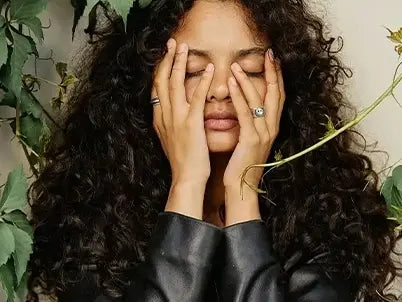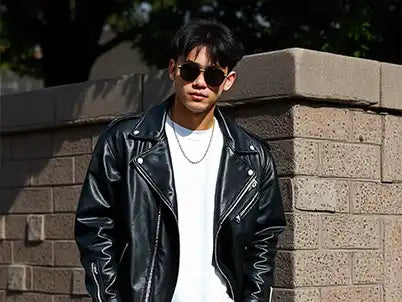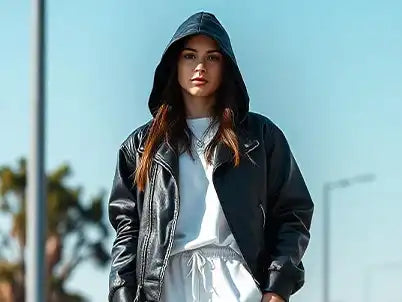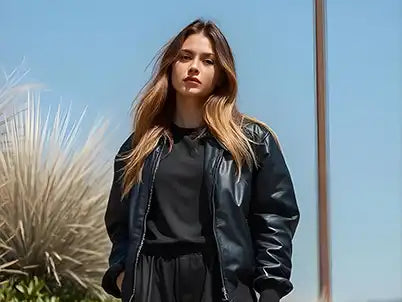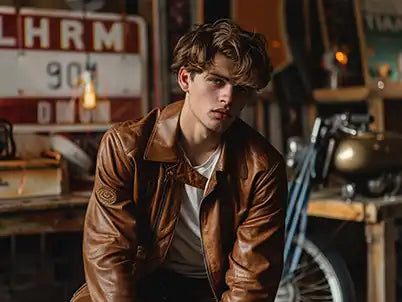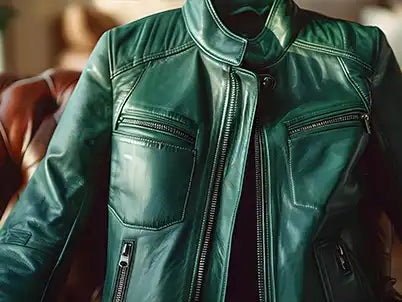Winter jackets are more than a mere cold-weather necessity; they combine functionality, fashion and technology to keep you warm, cozy and stylish in subzero temperatures or simply for everyday use. Understanding different types of winter jackets available as well as their materials and buying tips is paramount in finding something suitable.
Which Type of Jacket is Best for Winter?
Selecting the ideal winter jacket depends on factors like climate, activities and personal preferences. Here is a selection of best winter jackets for cold weather:

1. Parkas
Parkas are among the warmest winter jackets available, featuring longer lengths which offer additional insulation to protect upper thighs and legs from colder climates. They typically include fur-lined hoods for additional wind and snow protection making them perfect for harsh climates!
2. Puffer Jackets
Recognizable by their quilted design, women’s leather puffer jackets are lightweight yet incredibly warm. Puffed with either down or synthetic insulation, these lightweight coats trap heat effectively, making them popular among outdoor enthusiasts.
3. Leather Coats
For those who want a combination of style and warmth, men’s leather coats are an excellent choice. While not as insulating as parkas, these pieces can work in moderate winter climates by layering up sweaters under them for extra insulation.
4. Leather Jackets
Although typically associated with fall fashion, leather jackets can make an impactful winter statement when combined with shearling lining or layering appropriately. They make ideal options for urban environments in mild winter climates.
5. Fleece Jackets
Fleece jackets are lightweight, breathable layers ideal for layering. While not as warm as their insulated counterparts, fleece jackets make an excellent casual outing jacket or midlayer under heavier coats.
Which Type of Jacket is Warmest?

1. Down Jackets
Down jackets are often considered the warmest type of winter coat, made from duck or goose feathers filled with insulation properties that provide unmatched insulation by trapping body heat. However, their insulation diminishes quickly when wet without proper treatment such as waterproof coatings to retain their insulating power.
2. Synthetic Insulated Jackets
Jackets made of synthetic materials such as PrimaLoft or Thinsulate mimic the properties of down while offering more water resistance, providing reliable insulation in damp conditions while being slightly warmer than down jackets.
3. Shearling Jackets
Shearling-lined leather jackets provide maximum warmth. Their natural wool lining provides both comfort and heat retention.
Which Material Jacket is Best for Winter?
Your winter jacket material plays an integral role in its performance. Here are five highly effective choices:

1. Wool
Wool is an insulator made of natural fibers which keeps the wearer warm even when damp; this versatile fabric often used in peacoats or trench coats due to both style and functionality considerations.
2. Down
Down, on the other hand, is lightweight yet compressible and offers incredible warmth. An ideal combination for extreme cold environments but less effective against moisture unless treated with water-repellent coatings.
3. Gore-Tex
This waterproof and windproof fabric is often found in technical winter jackets for outdoor activities, offering both waterproofing and breathability for maximum comfort during high intensity activities.
4. Leather
Leather jackets provide wind resistance and timeless style in urban settings, and when lined with shearling they become functional winter apparel.
5. Synthetic Materials
Polyester, nylon, and other synthetic blends are popularly utilized in winter jackets because of their durability, water resistance, and insulation properties.
Buying Tips for Winter Jackets

1. Fit and Sizing
A good winter jacket should allow room for layering without being overly bulky. Ensure the sleeves cover your wrists, and the hem provides adequate coverage.
2. Insulation Type
Choose down for dry, cold climates and synthetic for wet conditions. Ensure the fill power (down quality) is at least 600 for adequate warmth.
3. Waterproofing
Look for jackets with waterproof coatings or membranes like Gore-Tex for maximum protection.
4. Durability
Inspect the stitching, zippers, and overall construction. Quality materials like wool and leather last for years with proper care.
5. Style and Versatility
Ultimately, selecting a jacket that complements both your personal style and function is of utmost importance. Leather and wool coats make an excellent statement piece that works in both casual and formal settings alike.
When selecting a versatile piece, consider how it fits your wardrobe. Knowing what to wear with a leather jacket, for instance, can help maximize its utility across seasons
How Do I Maintain a Winter Jacket?
Proper maintenance will extend the functionality and style of your winter jacket for years. Here is how you should take care of different kinds of winter jackets:

1. Cleaning and Washing
- Down Jackets: Spot-clean when possible and use a front-loading washing machine with a down-specific detergent. Air dry with dryer balls to restore the loft.
- Leather Jackets: Leather jackets should be maintained using a damp cloth and treated annually with leather conditioner to avoid exposure to water that may lead to cracking in the material.
- Wool Coats: When it comes to wool coats, only dry cleaning methods should be utilized; regularly brush the surface in order to prevent dust and debris accumulation.
- Synthetic Jackets: When caring for synthetic jackets, use mild detergent with specific care instructions available on their care label to wash in the washing machine using gentle cycles and follow their specific care label's recommendations.
2. Storage Tips
- To maintain their shape, jackets should be stored on wide and padded hangers. Doing this will preserve their form.
- Protect against mold and mildew growth with breathable garment bags designed to keep them out of harm's way. This will keep them from spoiling.
- Avoid storing in humid or damp environments in order to preserve insulation and fabric integrity.
Pros and Cons of Popular Winter Jacket Styles

1. Parkas
- Pros: Provide exceptional warmth with extended coverage in harsh winters.
- Cons: Large bulkiness limits mobility.
2. Puffer Jackets
- Pros: Lightweight, compressible, and extremely warm.
- Cons: Vulnerable to moisture penetration without being treated with water-repellent coatings.
3. Leather Jackets
- Pros: Durable, stylish, and wind-resistant.
- Cons: Limited insulation and requires proper layering for colder climates.
4. Wool Coats
- Pros: Stylish, breathable, and naturally insulating.
- Cons: Not waterproof and requires professional cleaning.
5. Technical Jackets
- Pros: Advanced features like waterproofing, windproofing and breathability make for advanced protection from the elements.
- Cons: Expensive and less flexible for casual wear than alternatives.
Which Type of Jacket is Often Worn in Winter?
Winter clothing preferences depend on lifestyle and environment:

- Urban Settings: Wool coats and leather jackets dominate for their sleek appearance.
- Outdoor Activities: Down and technical jackets are favored for their performance.
- Everyday Use: Puffer jackets and parkas offer a balance of warmth and comfort.
Advanced Features to Look For in Winter Jackets

1. Temperature Regulation
Some high-end winter jackets feature built-in temperature regulation technology to adapt to body heat fluctuations for maximum comfort in fluctuating temperatures.
2. Windproofing
Windproof jackets provide warmth on windy days and should include sealed seams and wind flaps for optimal performance.
3. Ventilation
Pit zips and breathable fabrics help regulate body heat during physical activities and are essential features in technical winter jackets.
4. Snow Skirts and Cuffs
These features prevent snow and cold air from entering, especially useful for skiing and snowboarding jackets.
5. Reflective Details
For safety during low-visibility conditions, reflective elements are a great addition.
What is the Difference Between a Jacket and a Winter Coat?

1. Design
- Jacket: Shorter in length, typically ending at the waist or hips.
- Coat: Longer, offering coverage below the waist for added warmth.
2. Weight and Warmth
- Jackets are lighter and suitable for moderate cold.
- Coats are heavily insulated and ideal for freezing temperatures.
3. Purpose
- Jackets prioritize mobility and style.
- Coats focus on maximum protection and warmth.
Styling Winter Jackets for Various Occasions

1. Formal Settings
For formal occasions such as business meetings and formal events, wearing a tailored wool coat with dress pants and leather boots creates a powerful impression.
2. Casual Wear
Puffer jackets and parkas make an effortless yet chic everyday ensemble when worn over jeans and sneakers.
Get an effortless yet fashionable look by pairing women's winter jackets with hoods with jeans and snow boots for everyday use, creating an ensemble that combines fashion and comfort in one package.
3. Outdoor Adventures
Technical jackets featuring insulated layers and snow boots are essential gear for skiing, hiking and snowboarding adventures.
4. Urban Chic
To achieve an effortlessly chic city aesthetic, pair a leather jacket with a turtleneck, dark jeans and Chelsea boots for a sleek urban aesthetic. Leather jackets for men combined with scarves or boots also make chic choices in urban settings.


